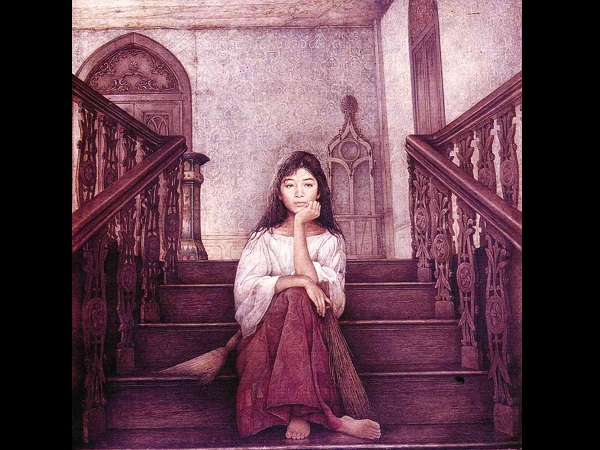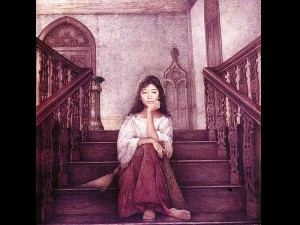
Mariang Alimango is one of several Cinderella-type stories in Philippine literature. In the 1990s I wanted to make it into an illustrated children’s book in two languages, the Filipino part by Virgilio S. Almario, who has since become National Artist, and the English part by me.
I engaged a relatively unknown representational painter named Antonio Mahilum to do the illustrations, since I had seen his fantastic craftsmanship in a brochure. What he lacked in imagination, I thought cockily, I’d supply. The paintings were to be in oil, about 2 ½ x 2 ½ ft size canvases.
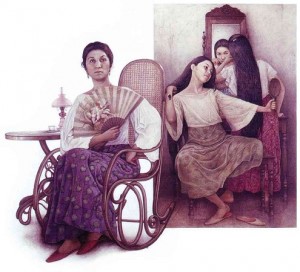
It had never been specified that Maria’s family was poor. Since GCF Books then was working on a “Philippine Ancestral Houses” book, I thought I’d give Maria a beautiful dwelling like the one we had photographed in Bustos, Bulacan.
Then I got more ambitious. I thought the book should also serve as a children’s primer on old houses. It would be useful also as a model for adult artists, who drew such awful bahay-na-bato as I often saw in weekend magazines.
Every object in Maria’s house was to be authentic to the period. Since Maria was treated like a servant, she had to be in the kitchen most of the time, so that, too, would be meticulously equipped.
Labor of love
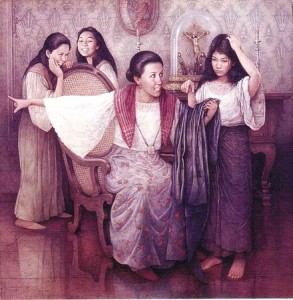
Most old stuff was easy to find, since I had then also an antique shop in Mabini. Tony had no familiarity whatsoever with antiques. I had to take every antique object to be illustrated to him or a picture thereof (expensive then, since there were no digital cameras yet). It was a heavy labor of love.
I was a stickler for authenticity. For instance, if the four-poster bed’s legs were too short and the stepsister’s feet reached flat on the floor, I would veto the painting. Tony would promise to replace it and I would see it no more.
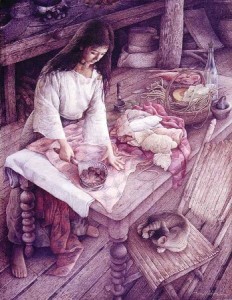
I was also overly proud of Tony’s work and brought friends over to his house to show them off. The trouble was that these people wanted to buy those paintings off him. (Over my dead body!). The paintings still belonged to me (since I had paid for the right to print and devoted so much of my time shepherding them).
When they were all completed, we would take good photos, then they would all belong to him. I never even thought of keeping one painting at home as insurance.
The project stretched on for months, then a year. Tony kept missing deadlines and was tiring of my strictness. Every time I went to his house, moreover, he was making some child’s portrait, ordered by friends whom I had taken there. It really annoyed me. He said he needed the money and I’d give him more.
I decided to jump to the illustration of the last page, the final painting, the wedding scene! When at last he showed it to me, I almost fainted! He had ignored the model of a 19th-century youth that I had provided him. The bridegroom’s face was of this era, and a popular matinee idol at that!
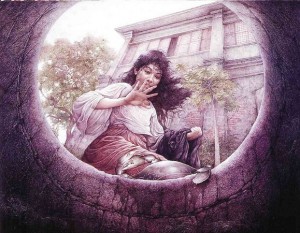
Tony hid the painting and never replaced it, nor a few other faulty paintings either. Then he transferred his home to Antipolo without leaving his address. I was tired of going after Tony. I lost track of him and the Maria paintings. All I had was an unfinished book and a broken heart. Then I heard that Tony died! I couldn’t believe my ears—he was young!
After a lot of sleuthing, I learned that he had sold the paintings to United Coconut Planters Bank (UCPB) and that they were in Mrs. Gretchen Cojuango’s house. Through friends I tried to contact Ms Cojuangco to get permission to photograph those I hadn’t, but never received a reply. I have not seen the paintings since. Where are they?
Recently, I came upon the few Maria photos in 120 negative format that I still had. I thought of sharing them with you.
(Any report of sightings of the Maria Alimango paintings will be highly appreciated. E-mail [email protected].)

